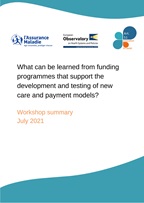
Innovation
Innovation is at the heart of health systems. Within health innovations, we distinguish between biomedical and technological innovation on the one hand and organizational innovation on the other. In practice, virtually all innovation in health and care is a combination of biomedical and technological innovation alongside organizational innovation. Each time a new medicine, technology, or technique is implemented, change is required, and this can include changes in procedures, skills, payment mechanisms, staff, or equipment. The European Observatory’s programme of work on innovation in health aims to support health systems in maximizing the potential of innovation to achieve the overall goals of health systems and policy.
Innovation is at the heart of health systems. The scope of medicine has increased enormously since modern health systems emerged, and it continues to do so. As a result of ever-improving drugs, technologies and techniques, diseases that were once fatal, or led to lasting ill-health, can now be treated with confidence. Constant biomedical research is needed to keep these medical innovations moving forward. Alongside biomedical research technological innovation – ranging from simple medical devices to emerging technologies such as artificial intelligence – has played an increasing role.
Yet this is only half of the story. Innovations in medicine create possibilities; but these possibilities mean nothing if patients do not benefit from them. This brings us to a second type of innovation – organizational innovation, meaning the changes in organizations and systems that are needed to bring medical innovations into practice. Each time a new drug, technology, or technique is implemented, change is required, and this can include changes in procedures, skills, payment mechanisms, staff, or equipment. These changes are themselves a vital form of innovation, for without them the possibilities created by biomedical innovation cannot be realized in practice.
This process of constant change is a central priority for health policy and systems. Innovation in healthcare has been identified as the central driver of the sustained increases in healthcare expenditures in developed economies. While the constant improvement in the capability of medicine has improved health, expanding what is possible also increases the overall scope and cost of care. This is not to say that all innovation increases costs. On the contrary, some innovations may decrease costs from the start, and over time costs of any given innovation typically decrease. Nevertheless, health innovation has been outpacing improved efficiency from innovation. In part, this may be in part due to the way that innovations are funded, with imbalances between where financial rewards are available and the greatest needs of health systems. This can be compounded by greater investment and research funding for biomedical innovation, rather than in the organizational and system changes needed to support efficient and appropriate care.
In practice, virtually all innovation in health and care is a combination of biomedical and technological innovation alongside organizational innovation. For its successful use, even a seemingly straightforward biomedical innovation, such as an anaesthetic, depends on organizational change, as well as support from medical technologies such as monitoring devices. This means that while biomedical and technological innovations have the potential forms universal impact throughout health systems, the impact they actually have dependent on the accompanying organizational innovations to put them into practice.
The Observatory’s programme of work on innovation in health aims to support health systems in maximizing the potential of innovation to achieve the overall goals of health systems and policy. This explores:
The overall health innovation system: how biomedical innovations are generated, what funding and incentives are available, how these shape the development of innovations available to health systems, and how these innovation systems can be better aligned with the needs of health systems.
- Implementing innovation: how can health systems better support processes of implementation, learning and change?
- Learning from each other: how can each unique health system learn from good practice elsewhere?
- The European and global context: what steps can be taken at European and international level to help maximise the potential of innovation in health?
Innovation topics
Related publications
Use of digital health tools in Europe: before, during and after COVID-19
This brief’s key messages are: Digital health tools hold the potential to improve the efficiency, accessibility and quality of care....
View online Health services research increasingly relies on data linkage, including to datasets outside the health sector Evidence-based health policy...
What are the implications of policies increasing transparency of prices paid for pharmaceuticals?
Policy action on net price transparency (NPT) for pharmaceuticals – the public disclosure of prices paid to manufacturers – is not straightforward:...
Repurposing of medicines in oncology – the underrated champion of sustainable innovation
Some of the brief’s key messages are: Repurposing is a strategy to identify new uses for approved or investigational medicines ...

Skill-mix Innovation, Effectiveness and Implementation: Improving Primary and Chronic Care
What are skill-mix innovations in the health workforce and why are they relevant? This systemic analysis of health workforce skill-mix innovations provides...
This brief’s key messages are: The TO-REACH project addressed what the key priority areas are where European health systems can learn from...
How can skill-mix innovations support the implementation of integrated care for people with chronic conditions...
The increasing and changing demands of complex patients (with chronic conditions and multimorbidity), combined with growing workloads and shortages...

Europe’s Beating Cancer Plan Consultation: an Overview
In early 2020, the European Commission launched a major consultation process on the Europe’s Beating Cancer Plan (EBCP) that focuses on the future...

What can be learned from funding programmes that support the development and testing of care and payment...
Different health systems have different strategies in relation to funding innovation in health. Finding new care and payment methods that improve patient...
What are the key priority areas where European health systems can learn from each other?
This brief’s key messages are: The TO-REACH project addressed what the key priority areas are where European health systems can learn from each...

Europe’s Beating Cancer Plan Consultation: factual report from the targeted stakeholder consultation
In early 2020, the European Commission launched a major consultation process on the Europe’s Beating Cancer Plan (EBCP) that focuses on the future...
Ensuring access to medicines: how to stimulate innovation to meet patients’ needs?
This policy brief from the European Observatory on Health Systems and Policies is one of a series on addressing market and policy failures in the pharmaceutical...
Related events
Subscribe to our newsletter
Sign Up